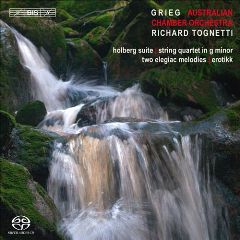Edvard Grieg - Music for String Orchestra (2012)
Edvard Grieg - Music for String Orchestra (2012)

String Quartet No. 1 in G minor, Op. 27 (1878) I. Un poco andante - Allegro molto ed agitato II. Romanze: Andantino - Allegro agitato III. Intermezzo: Allegro molto marcato - Allegro agitato IV. Finale: Lento - Presto al saltarello Two Elegiac Melodies for string orchestra, Op. 34 (1880) 5. Hjertesar (The Wounded Heart) 6. No. 2. Varen (Last Spring) Lyric Pieces, Book 3, Op. 43 (arr. R. Tognetti for violin and string orchestra) (1886) 7. Erotikk, Op. 43 No. 5 Fra Holbergs tid (Holberg Suite), Op. 40 (1884/1885) 8. I. Prelude 9. II. Sarabande 10. III. Gavotte 11. IV. Air 12. V. Rigaudon Australian Chamber Orchestra Richard Tognetti – conductor
Richard Tognetti's all-Grieg album with the Australian Chamber Orchestra focuses on music for string orchestra, including two arrangements that are premiered here. The familiar Holberg Suite is the main attraction, and listeners who are charmed by this evergreen are likely to take a chance on Tognetti's handiwork in his expanded versions of the String Quartet in G minor and the piano gem, Erotik. In a sense, the string quartet lends itself to a large-ensemble treatment more readily than a keyboard piece could, and the choices Tognetti made are idiomatic to the string orchestra, if not necessarily to the string quartet genre. The thickness of the string sections may be disconcerting to any who know the quartet, though to Tognetti's credit, he has retained some repartée for solo instruments, or allowed them to play passages in a concertante style, so the arrangement has sufficient connections with the original and ample contrasts and dramatic interchanges to sustain interest. Erotik, on the other hand, is a lush but simple setting for solo violin and string orchestra that stays in the lyrical vein for its short duration, and like the two Elegiac Melodies, has a subdued character that is in contrast to the volatility of the quartet. Tognetti's violin solos are tailored to his sweet tone and generous bowing, and the orchestra seems wholly in tune with his passionate ideas and interpretations. The super audio reproduction is quite clear and vivid, and BIS has taken great pains to avoid the gray, undifferentiated sound so common to string orchestra recordings. ---Blaur Sanderson, Rovi








